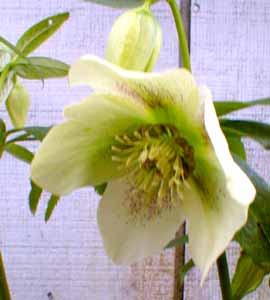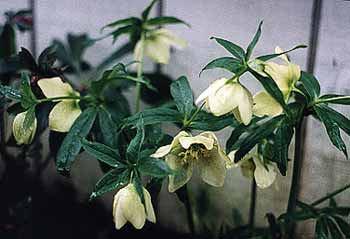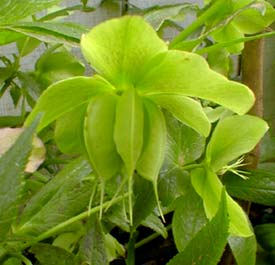 'Heronswood Yellow'
'Heronswood Yellow'
Hellebore
"Over which thine eyebrows, leaning,
Picture out each lovely meaning:
In a dainty bend they lie,
Like to streaks across the sky,
Or the feathers from a crow,
Fallen on a bed of snow.
Of thy dark hair that extends
Into many graceful bends:
As the leaves of Hellebore
Turn to whence they sprung before. "
-John Keats
(1795-1821)
(1795-1821)
Our hellebores are in full large bud early in January though new leaves are barely starting. The "Mixed Border" hellebore though youngest in our garden blooms first every year; its buds begin to fully open very early January, & a maroon-black variety called 'Slaty' opens its heavy load of blooms later than the others, beginning late February.
'Heronswood Yellow' is opening its buds some years by the beginning mid-January but never impressively flowerful until February, increasing in beauty through March.
 It has largest buds of the varieties we have, opening into larger than average flowers. By late April & May it will have added a full complement of fresh large leaves & still be just as full of flowers.
It has largest buds of the varieties we have, opening into larger than average flowers. By late April & May it will have added a full complement of fresh large leaves & still be just as full of flowers.It's planted very near the 'Rose Madder' also developed at the world-famed Heronswood Nursery. The Yellow is in full bloom ahead of 'Rose Madder,' then they bloom together for the rest of winter & long into spring.
Underneath & between these two hellebores is a patch of early-spring blooming Bloodroot which blooms very briefly but has oddly shaped leaves poking out from under the hellebore for the rest of spring.
Though often called shade plants, in the Northwest hellebores like a good deal of sunlight. Though ours are planted in a shade corridor, they have a long day of indirect sunlight, then a bit of direct sunlight in the afternoon. 'Heronswood Yellow' & 'Rose Madder' grow next to a concrete foundation, plus there's a concrete slab down below the soil protecting a gas main. Since hellebores like neutral soils, or soils slightly more alkaline than our naturally acidic topsoils, the proximity of the cement & concrete might provide some minor alkalinization, though I also "feed" the hellebores an annual stick of chalkboard chalk pressed into the center of each root mass, which lowers acidity for its roots without changing the nature of the surrounding topsoil.
 In 2002 the Yellow was the first of the hellebores to stop blooming (though they all bloom a very long while) & was also first in winter to have its evergreen leaves sufficiently beat-looking to need to be trimmed back. That was possibly a fluke of happenstance & its leaves weathered the winter of 2002/3 much better. In winter of 2003/4, all the hellebores' evergreen leaves looked badly beaten by January, so I clipped away nearly all of them.
In 2002 the Yellow was the first of the hellebores to stop blooming (though they all bloom a very long while) & was also first in winter to have its evergreen leaves sufficiently beat-looking to need to be trimmed back. That was possibly a fluke of happenstance & its leaves weathered the winter of 2002/3 much better. In winter of 2003/4, all the hellebores' evergreen leaves looked badly beaten by January, so I clipped away nearly all of them.Most years, I preserve the hellebore leaves as long as possible, trimming them off one by one as they begin to look tawdry, but by late winter any remaining old leaves should be clipped off to make room for the new, even when the old ones are still nice looking.
The color of this cultivar is called butter-yellow by the grower, but really it blooms creamy white. Heronswood advertises it as one of the yellowest hellebores, but one would have to be hallucinating to fancy this specimen as actually yellow. It's gorgeous even so. Most of the creamy-white flowers have a light sprinkling of rose freckles within. I will occasionally lift a few of the dangly flowers & lay them face upward on the leaves just so I can see the freckled insides as I walk along that path.
The first photo was taken on the second day of March (2004). The second photo is from February (2003), with new leaves as yet small so that the flowers dominate. The third photo shows a seed pod in late April, itself a very long-lasting "decoration" for the clump, & of a rich yellow-green coloration. It was the only pod to develop in 2003, & its presence in no way slowed down the other stems from continuing to produce flowers. When the first segment of one of these pods cracks open, it's time to harvest it & let the rest of pod-chambers finish opening indoors so the seeds can be gathered.